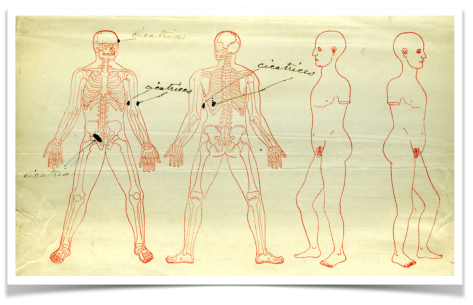
In the fighting at Hatcher’s Run on 5 February 1865, Corporal Edson DeWolf Bemis (1841-1900) of Co. K, 20th Massachusetts Regiment received a traumatic head wound from a minié ball that entered his left temple and lodged deep within the brain. When he was brought into the field hospital, the surgeon, a 23 year-old recent graduate of Columbian University (now George Washington University) named Albert Vander Veer (1841-1929), noted that Edson’s condition was dangerous, perhaps mortal: “Brain matter was oozing from the wound. There was a considerable hemorrhage, but not from any important vessel…the right side was paralyzed and there was total insensibility.” But two days later, after having probed deep within the skull to remove the ball, Surgeon Vanderveer reported that the patient’s condition miraculously improved. Edson told the surgeon his name, and seemed conscious of all that was going on about him.
Thus began one of the most famous and carefully detailed case studies of traumatic brain injury occurring in the American Civil War captured in the multivolume Medical and Surgical History of the War of the Rebellion (MSHWR). Additionally Edson Bemis’s injuries have been the subject of several articles (he was wounded twice before in the war) and will not be repeated here but I refer the reader to articles on Bemis from the National Archives, Dillon Carroll’s doctoral dissertation entitled, Scourge of War: Mental Illness & Civil War Veterans; and a New York Times article by Carroll entitled, The Civil War and P. T. S. D.
Edson Bemis was the son of Joseph Bemis (1803-1853) and Betsy Cole (1806-1882) of Chester, Hampden county, Massachusetts. He initially enlisted in the 15th Massachusetts but was transferred to the 20th Massachusetts in June 1864 prior to the head wound that resulted in his discharge from the service. In 1869, Edson married Jane A. (“Jennie”) Austin and moved to Suffield, Hartford county, Connecticut. By 1880, the couple had four children.
The following letter was written only 7 months after his catastrophic injury and demonstrates how well he was able to function at that time which was nothing short of remarkable even by modern-day medical standards. Over time, however, Edson suffered neurological deterioration (“cerebral degeneration as a result of gunshot wounds during the Civil War”) resulting in his death on 9 November 1900 at North Brookfield, Worcester county, Massachusetts. He was 59 years, 7 months and 3 days old (having cheated death for over 36 years).
See also—1862-65: Rebecca Hand to Albert Vander Veer on Spared & Shared 13.
[Note: This letter is from the personal collection of Richard Weiner and is published here by express consent.]

TRANSCRIPTION
Chester Center, Massachusetts
October 24th 1865
Sir,
I received a letter from you on the 20th of this month stating that you would send the ball and pieces of bone that was extracted from my brain. I would be very happy to have you send them to me.
My head is getting along very well. I have got so that I have to work some but not much. My head runs [oozes] some yet and I think that it always will. I wear a small piece of plaster on my head so if you see anyone that has a piece of plaster on his head just about as large as the Third Corps mark on his head, then you may think that it is E. D. Bemis. But sir, if my country had to go through another such a trial as another rebellion as this, I think that I should go and try my hand with them again.
Now I would like to have you send me a written statement of the wound that I received on the 5th day of February. There is some people here that does not believe that the ball ever went in as far as I say it did. You can tell how much brain ran out.
I would like to have you send the ball and bones to me as soon as you can and give me that written statement as soon as you can too. Send them to Chester Center, Mass.
— Edson D. Bemis


